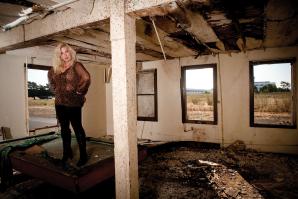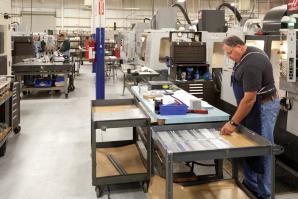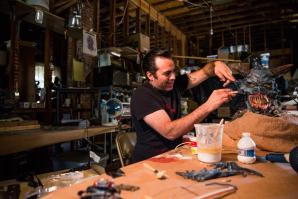Deon Taylor founded Deon Taylor Enterprises in 2004.

Building a $50 million company from the ground up in six years doesn’t take a rocket scientist, but it does take one hell of an entrepreneur. Deon Taylor, the 36-year-old mettle behind Deon Taylor Enterprises, is that kind of guy.
As a resident of South Sacramento, Taylor played basketball at San Diego State on an athletic scholarship. The Nike All-American majored in biology and planned to become a pediatrician, but while playing ball internationally, things changed.
“There’s only so much basketball you can play, and I had a hard time with the language barrier, so I had people ship me hundreds of movies,” Taylor says. “I got fascinated with story lines and horror films, and within six months of being there I was writing my first screenplay on a Mead pad.”
The screenplay was for “7eventy 5ive,” a stalk-and-slash tale of a harmless game turned bloody battle. Participants in the game call random telephone numbers in attempts to scare the receiving party for 75 seconds. Should the recipient laugh or hang up, the player loses, and the player with the best call emerges victorious. But when one player calls the wrong person, the once-playful game turns deadly.
“I’ve always been surrounded by NBA and NFL guys, … and I would pitch the movies to them,” he says. “Once I started getting the feeling that people were interested, my mind was focused.”
Eventually he pitched the movie, budgeted at $150,000, to a friend familiar with low-budget acting and producing who told Taylor he really needed $1.5 million. “I’m always optimistic, so I said, ‘let’s go get a million dollars.’” A few months later, funding in hand, Taylor consulted a bigwig director of photography, who took one look at the script and told Taylor he would need double the money. “I thought, ‘Aw, this is never going to happen. I went home, went to bed, woke up and found [$1.5 million more] in three days,” he says.
Spend any time with Taylor and it’s not hard to figure out how he managed. The Chicago native oozes charisma. Just being in a room with the guy makes you want to finance something.
“What makes me crazy and a little bit different is that you can’t tell me no,” he says. “I’ll write the script. I’ll make the trailer. I make stuff happen.”
A production virgin, Taylor and his team shot “7eventy 5ive” in 22 days — and entirely in Sacramento. The film had a limited theatrical release in 2009.
Earlier this year, “7eventy 5ive” was renamed “Dead Tone” and released on DVD. Taylor was elected filmmaker of the year at both the San Francisco International Film Festival and the Sacramento International Film Festival in 2007 and 2008. He’s worked on side projects, including a documentary about Tyreke Evans marketed toward ESPN and MTV, and with everyone from Flavor Flav to Magic Johnson. He owns other media outlets, including Taylor Made Muzik, his independent record label in Northern California, and he has independently financed all five of his films, which have held budgets of up to $5.7 million.
This year, Taylor will be working on his most expensive project to date, an action flick called “Free Agent” budgeted at $12.5 million. His $5 million horror film “Chain Letter” opens worldwide Aug. 6.
After the production of his second movie, “Night Tales,” Taylor saw a return on his investment after about 18 months. The film has made nearly $3 million to date. Now, his films are bringing in revenue after just six months, and he’s got a list of celebrity business partners, including former Sacramento Kings Mitch Richmond and Bobby Jackson.
Taylor says he’s reaching success by following the lead of media mogul Tyler Perry.
Perry, who burst onto the Hollywood scene in 2005 with his $5.5 million movie, “Diary of a Mad Black Woman,” was ranked by Forbes in 2009 as the sixth-highest paid man in Hollywood. As of last summer, Perry’s films had grossed nearly $400 million worldwide. His business model is simple: produce a hit with a modest budget. Lately, Perry’s movies, including last years’ “Madea Goes to Jail,” have been costing roughly $10 million a piece, but gross nearly five times that amount. He produces about four movies a year.
The strategy is working. According to BusinessWeek, in 2006 Perry had a 120 percent return on investment, meaning that for every dollar paid in marketing and production costs for his films, Perry returned $2.20. That’s better than Tom Cruise and Will Smith combined. Taylor likes those odds, so his model is identical.
Still, Taylor’s business choices beg a question.
“I wake up every morning and ask myself, ‘Why Sacramento?’” he says. And he’s not the only one asking. “It’s the biggest question I get from people.
“I have a 5-year-old, and I enjoy being in a market where I can raise a child … on an island removed from L.A. Plus, Sacramento can double for so many different cities. You can get urban, suburban, the city, the hood. It’s got everything,” he says.
But there are costs born from operating outside the Hollywood spectrum. Just to rent a camera rig and a qualified operator is hugely expensive, says Martin Anaya, director of the Sacramento Film Festival. “There just aren’t the trained crews in Sacramento. You have to rent the stuff, hire the people and pay their unions just to come up here and shoot. And where is the advantage in that?”
It all adds up to about $500,000 per production for Taylor, and more and more he’s saying the cost isn’t worth the headache.
“We’ve spent a lot of money on locations. We booked out Oak Park for $2 million (to film “The Hustle”), renting liquor stores and churches and hiring extras, who were locals. This is all money pouring back into this market,” he says. “You would think if I was bringing in A-list celebrities, someone would give me some hotel rooms. We’re spending hundreds of thousands of dollars a month here, and they’re not even giving me streets. We haven’t had any help here.”
Taylor says he missed the opportunity to shoot a major music video in Sacramento with actor Jamie Foxx and recording artists Justin Timberlake and T.I. because he couldn’t get streets blocked off for production on short notice.
“But that’s the way it is anywhere you film,” counters Sacramento Film Commissioner Lucy Steffens. “If it’s done with enough time to coordinate, we can do it. If you request police officers the day before you need them, that might be a challenge.”
Filming in Sacramento means big money for the city, so it’s Steffens job to make it happen. She does that by conducting tours for location managers, participating in trade shows and helping film crews cut through red tape.
According to the Association of Filmmakers International, shooting a low-budget, independent feature film, such as those produced by Deon Taylor Enterprises, will bring $30,000 a day to the local community. And television shows can have the same impact. When ABC’s Supernanny was shot on location in Sacramento, cast and crews booked 230 hotel nights. When the Mentalist was shot here, they needed 300 room nights.
Since the launch of the cinema industry nearly 100 years ago, Sacramento has offered producers a plethora of settings and sights. “Memoirs of a Geisha” filmed two days in Old Sacramento’s historic passenger station, which was a stand-in for a rural and an urban Japanese train station. “Man Without a Country” was filmed here in 1917, as was Huckleberry Finn in 1931. In all, Sacramento has played host to more than 70 movies, including award-winners like “American Beauty” and “Almost Famous.”
“It’s a rich history. And I wouldn’t say we have an industry, but I would call it a community,” Anaya says. “We would like to see Sacramento reassume the mantle, but I don’t have any false illusions.”
Whatever Sacramento might lack in size and sizzle could be made up in technology. Down the road, that could spell big bucks for the local media community.
“If your technology and personnel don’t have all those costs and you can still render a competitive image, then you’re not so tied up, and you can call home wherever you want to lay your hat,” Anaya says. “Because of our relative advantages in the realm of technology and our tech sector, and the reality that more motion pictures are going to be shot like “Avatar” and less like “Gone with the Wind,” Sacramento has a huge infrastructure potential for being a hub of this new methodology.”
The new digital methods — take for example the Red One digital video camera (see Comstock’s Jan/Feb 2009 issue) — never even touch film. Data is stored on hard drives. The foremost Red One camera operator in the industry is Joseph Arthur, and he lives right here in Sacramento.
“As we march forward, these things will become more of the norm,” Anaya says. “And when that happens, we are poised as a region to take advantage of that.”
Recommended For You

Voted Off the Island
Dream studio for filmmakers dissolves amidst Vallejo debate
Carissa Carpenter had her eye on Mare Island for the location of a state-of-the-art movie and television studio plus production company. Headed by Carpenter and studio president Howard Kazanjian, renowned producer of blockbuster films such as “Raiders of the Lost Ark” and “Star Wars: Episode VI – Return of the Jedi,” the studio aimed to be an alternative to Hollywood’s heavily booked and expensive movie sound stages.

The Auburn Advantage
How one city turned lifestyle into business leads
Downtown Auburn has a distinct, modern-day Mayberry feel, from the stone-paved sidewalks to the rustic brick bus stop. But five miles away,



